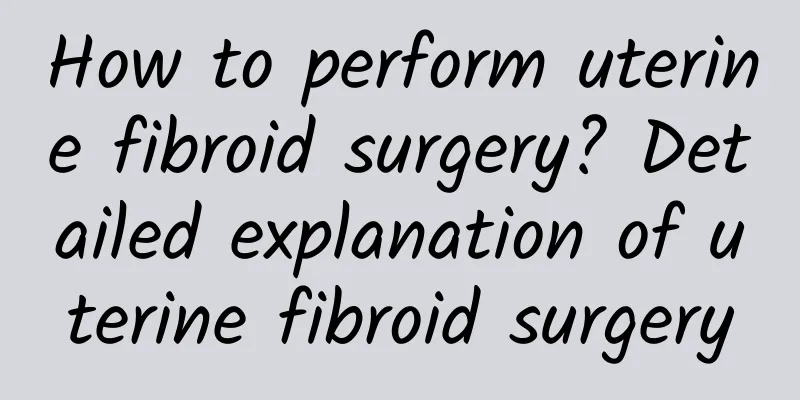How to perform uterine fibroid surgery? Detailed explanation of uterine fibroid surgery

|
Uterine fibroids are the most common benign tumors of the female genitalia. Most are asymptomatic, and a few present with vaginal bleeding, abdominal tumors, and compression symptoms. With the widespread use of minimally invasive surgery in clinical practice, most uterine fibroid surgeries can be performed through laparoscopy and hysteroscopy. So what are the steps of uterine fibroid surgery? Uterine fibroid surgery steps: 1. Caesarean section, in the lower abdomen, there are four layers: skin, subcutaneous tissue, rectus sheath, and peritoneum. In this process, we should also pay attention to the problem of bleeding. If many small bleeding points are not treated in time, they will continue to bleed, making the surgical field unclear. If the operation time is long, it will also lead to unnecessary excessive blood loss. Generally speaking, use hemostatic forceps for a period of time before cutting. 2. Expose the surgical field, find the uterus, and determine whether the uterus and fibroids are consistent with the preoperative diagnosis. 3. Find, separate, cut and suture the round ligament of line 7. 4. Make a small hole in the avascular part of the broad ligament. Clamp the fallopian tube and the ovarian ligament, and pass the clamp tip through the hole. Cut and suture. The peritoneum is folded open and peeled downward to expose the cervix. Be careful not to injure the bladder. 6. Find the uterine movement and vein on the cervical side, clamp the blood vessels close to the cervix (to prevent damage to the ureter), cut and suture. Then deal with the uterosacral ligament and cardinal ligament. 7. Touch the vaginal end of the cervix with your hands, make a small incision on the anterior vaginal dome, and cut off the vagina along the dome ring. Disinfect the incision with 5% iodine and 75% alcohol. 8. Suture the vaginal stump and peritoneum. 9. Check the abdomen for hemostasis before closing the abdomen. The pelvic infundibulum ligament, uterine blood vessels and the downward bladder are prone to bleeding. If loose adhesions are found after laparotomy, blunt separation can be used. If the adhesions are dense, try to separate them sharply under direct vision instead of forcing blunt separation. |
<<: When must patients with uterine fibroids undergo surgery? Pay more attention to these 4 symptoms
>>: What should patients with uterine fibroid surgery eat? Dietary care methods for uterine fibroids
Recommend
Why does premature ovarian failure occur?
Why does premature ovarian failure occur? Prematu...
The cause of vulvar leukoplakia is unknown, but there is some knowledge that patients need to know
If women do not pay attention to personal hygiene...
The main factors that cause dysmenorrhea
I believe that many female friends should be fami...
Will uterine prolapse recur after treatment?
Will uterine prolapse recur after being cured? Ut...
How is minimally invasive surgery for uterine fibroids performed? How to maintain after minimally invasive surgery for uterine fibroids
Uterine fibroids are the most common benign tumor...
Lowering cholesterol, improving fatty liver, 4 major benefits of mulberries! Nutritionist Hong Ruopu: 4 tips for choosing mulberries
Office workers who often eat out for three meals ...
Is it difficult for women with thick endometrium to get pregnant?
The endometrium is like the "soil" for ...
Three preventive health care measures for women's ectopic pregnancy
Women should go to the hospital to check whether ...
During the recovery period of cervical erosion, we must pay attention to the details of life
Cervical erosion is a common gynecological diseas...
What are the causes of irregular menstruation? 5 common causes of irregular menstruation
1. Stress: Women are in a state of long-term supp...
What are the most effective common sense to fight vaginitis?
Vaginitis is of course a common gynecological dis...
Brief analysis of physical methods for treating cervical erosion
With the continuous improvement of medical techno...
How do women with uterine fibroids present?
What are the symptoms of uterine fibroids in wome...
Diet for threatened abortion
Aura also refers to precursors and signs. Pregnan...
How much harm does abortion do to women?
How much harm does abortion do to women? Abortion...









